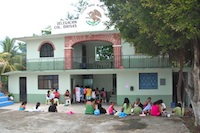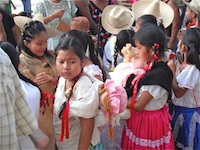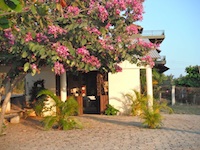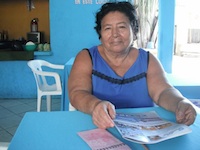Brisas de Zicatela: The Story of a Land Invasion
Those who know won't say, and those who say make it up. In broad strokes, this is a rough draft of the history of the Punta.
The conflict between the municipios of Santa María Colotepec and San Pedro Mixtepec over Puerto Escondido goes back at least to the 1920s when the coffee from Nopala and San Gabriel was shipped from what is now the parking lot next to the dock at the end of Playa Principal. (There was no dock then, the coffee was borne on flat-bottomed canoes to the ships waiting off shore.) According to one 19th century geographic survey carried out by the state of Oaxaca, Puerto is part of San Pedro Mixtepec; in another it is shown as belonging to Santa María Colotepec.
People in Colotepec say that they renounced their claim to Puerto, including all of Zicatela, in a meeting with the governor shortly before the 1970 federal expropriation during which they were promised electricity, potable water, roads, and a health center. Another story is that money changed hands.
So when Puerto was expropriated from Punta Colorada to the Punta of Zicatela for Fonatur (the National Fund for the Promotion of Tourism) to develop as a major resort, the entire zone was deemed to belong to San Pedro Mixtepec. The land in what is now the colonías of Brisas de Zicatela, Tamarindos, and Santa María was deeded to undisclosed parties in Mexico City and elsewhere who stood to make a great profit when the international resorts came in.
Fast forward to 1982. There are no resorts, but Fonatur is still a player. Colotepec still lacks electricity, potable water, roads etc. Alejandro Cárdenas Peralta, a native of Pochutla, is the federal deputy for District 10 which includes Colotepec. (San Pedro Mixtepec is in District 11.) Justo Salvador Maldonado is the newly-elected president of the Bienes Comunales of Colotepec. The two men lead an “invasion” of Brisas de Zicatela, reclaiming it for Colotepec. Cárdenas is murdered in February 1985, and Salvador five years later.
The land is virgin forest, huizache trees with long thorns and mesquite. Justo Salvador issues a proclamation offering actas de posesión on small lots for anyone from anywhere (not just from Colotepec) who is willing to clear the land. There are advertisements in newspapers and on the radio. Many people come from Miahuatlán (there is already a history of migration from that region to Puerto) which is the birthplace of Justo Salvador.
Amancia Márquez Reyes, proprietor of the restaurant "Doña Amancia" on calle Tamaulipas, was a 40 year-old widow with 4 children living in rented rooms in Puerto's Colonia Benito Juárez in 1982. A native of San Pedro Atoyac, a small municipio in the mountains near Pinotepa Don Luis, she came to Puerto after having lived many years in Jamiltepec. There were many widows like her who responded to Justo Salvador's call. Their job was to clear the branches the men cut with their machetes. When she was given her lot she built a palapa for her family.
Most of the people who were given lots did not live on them, however. There were no roads; there was no power until 1990, and no potable water until 2000. Light came from kerosene lamps and water from a communal well. The women did their wash on Saturdays at the Colotepec River in La Barra.
More typical was the case of José Silva's mother who supported her family in Puerto by making tamales. She and her sons also cleared the land and were given lots which they fenced and maintained. She sold hers in 1996 to cover the costs of a family emergency. Others sold their lots to buy tractors or pick-up trucks. There is no doubt but that many poor people profited by the distribution of the land.
The invasion of Zicatela led to the area being legally denominated as a “zone of conflict” between the two municipalities. Fonatur gave up its plans for Puerto in 1984 and moved on to Huatulco. Up until a few years ago, the land was still mostly unoccupied, record keeping was bad, and some of the local authorities were venal. New actas got issued, and it was not unheard of for there to be two or more actas for the same lot.
Today, however, the situation is much improved. Fonatur's plan for large hotels never came to fruition, but the last 15 years have seen a building boom in vacation houses and apartments. Land now goes for between 1,000 and 2,000 pesos a square meter, but it is still probably the most affordable beachfront community on the Pacific coast of Mexico, with all the amenities of Puerto Escondido only a few minutes away.















